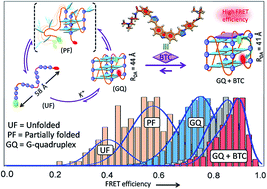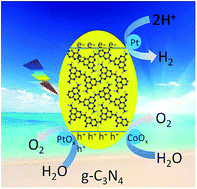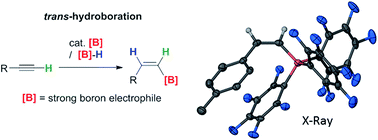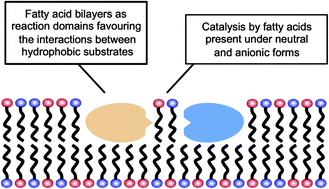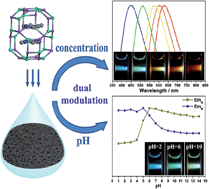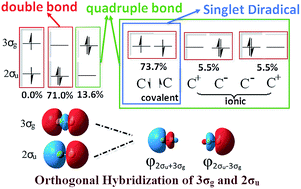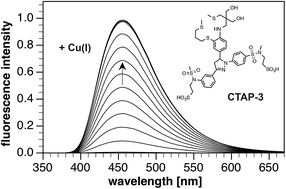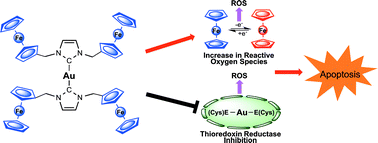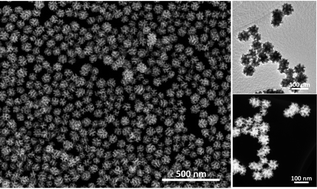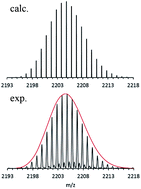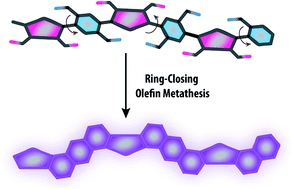Take a look at the 25 most-downloaded Chemical Science articles from the first quarter of 2016 – many are open access.
Which conformations make stable crystal structures? Mapping crystalline molecular geometries to the conformational energy landscape
Hugh P. G. Thompson and Graeme M. Day
Chem. Sci., 2014, 5, 3173-3182, DOI: 10.1039/C4SC01132E, Edge Article
Open access
Pot economy and one-pot synthesis
Yujiro Hayashi
Chem. Sci., 2016, 7, 866-880, DOI: 10.1039/C5SC02913A, Perspective
Open access
Macrocycles: lessons from the distant past, recent developments, and future directions
Andrei K. Yudin
Chem. Sci., 2015, 6, 30-49, DOI: 10.1039/C4SC03089C, Perspective
Open access
Evaluating metal–organic frameworks for natural gas storage
Jarad A. Mason, Mike Veenstra and Jeffrey R. Long
Chem. Sci., 2014, 5, 32-51, DOI: 10.1039/C3SC52633J, Perspective
Open access
Reversible photo-induced trap formation in mixed-halide hybrid perovskites for photovoltaics
Eric T. Hoke, Daniel J. Slotcavage, Emma R. Dohner, Andrea R. Bowring, Hemamala I. Karunadasa and Michael D. McGehee
Chem. Sci., 2015, 6, 613-617, DOI: 10.1039/C4SC03141E, Edge Article
Open access
The ligand unwrapping/rewrapping pathway that exchanges metals in S-acetylated, hexacoordinate N2S2O2 complexes
J. A. Denny, W. S. Foley, A. D. Todd and M. Y. Darensbourg
Chem. Sci., 2015, 6, 7079-7088, DOI: 10.1039/C5SC02269J, Edge Article
Open access
Rethinking the term “pi-stacking”
Chelsea R. Martinez and Brent L. Iverson
Chem. Sci., 2012, 3, 2191-2201, DOI: 10.1039/C2SC20045G, Perspective
From themed collection Physical Chemistry
Structurally plastic peptide capsules for synthetic antimicrobial viruses
Valeria Castelletto, Emiliana de Santis, Hasan Alkassem, Baptiste Lamarre, James E. Noble, Santanu Ray, Angelo Bella, Jonathan R. Burns, Bart W. Hoogenboom and Maxim G. Ryadnov
Chem. Sci., 2016, 7, 1707-1711, DOI: 10.1039/C5SC03260A, Edge Article
Open access
A versatile synthetic route for the preparation of titanium metal–organic frameworks
Lanfang Zou, Dawei Feng, Tian-Fu Liu, Ying-Pin Chen, Shuai Yuan, Kecheng Wang, Xuan Wang, Stephen Fordham and Hong-Cai Zhou
Chem. Sci., 2016, 7, 1063-1069, DOI: 10.1039/C5SC03620H, Edge Article
Open access
Dual gold/photoredox-catalyzed C(sp)–H arylation of terminal alkynes with diazonium salts
Adrian Tlahuext-Aca, Matthew N. Hopkinson, Basudev Sahoo and Frank Glorius
Chem. Sci., 2016, 7, 89-93, DOI: 10.1039/C5SC02583D, Edge Article
Open access
Sulfonyl fluorides as privileged warheads in chemical biology
Arjun Narayanan and Lyn H. Jones
Chem. Sci., 2015, 6, 2650-2659, DOI: 10.1039/C5SC00408J, Perspective
Open access
Asymmetric supercapacitors with high energy density based on helical hierarchical porous NaxMnO2 and MoO2
Xue-Feng Lu, Zhi-Xiang Huang, Ye-Xiang Tong and Gao-Ren Li
Chem. Sci., 2016, 7, 510-517, DOI: 10.1039/C5SC03326H, Edge Article
Open access
Vitrimers: permanent organic networks with glass-like fluidity
Wim Denissen, Johan M. Winne and Filip E. Du Prez
Chem. Sci., 2016, 7, 30-38, DOI: 10.1039/C5SC02223A, Minireview
Open access
Metal–organic framework-based CoP/reduced graphene oxide: high-performance bifunctional electrocatalyst for overall water splitting
Long Jiao, Yu-Xiao Zhou and Hai-Long Jiang
Chem. Sci., 2016, 7, 1690-1695, DOI: 10.1039/C5SC04425A, Edge Article
Open access
Aromatic hydrocarbon macrocycles for highly efficient organic light-emitting devices with single-layer architectures
Jing Yang Xue, Tomoo Izumi, Asami Yoshii, Koki Ikemoto, Takashi Koretsune, Ryosuke Akashi, Ryotaro Arita, Hideo Taka, Hiroshi Kita, Sota Sato and Hiroyuki Isobe
Chem. Sci., 2016, 7, 896-904, DOI: 10.1039/C5SC03807C, Edge Article
Open access
Peptide-based synthetic vaccines
Mariusz Skwarczynski and Istvan Toth
Chem. Sci., 2016, 7, 842-854, DOI: 10.1039/C5SC03892H, Minireview
Open access
Accurate calculation of the absolute free energy of binding for drug molecules
Matteo Aldeghi, Alexander Heifetz, Michael J. Bodkin, Stefan Knapp and Philip C. Biggin
Chem. Sci., 2016, 7, 207-218, DOI: 10.1039/C5SC02678D, Edge Article
Open access
Thin metal nanostructures: synthesis, properties and applications
Zhanxi Fan, Xiao Huang, Chaoliang Tan and Hua Zhang
Chem. Sci., 2015, 6, 95-111, DOI: 10.1039/C4SC02571G, Minireview
Open access
Combination of Ru(II) complexes and light: new frontiers in cancer therapy
Cristina Mari, Vanessa Pierroz, Stefano Ferrari and Gilles Gasser
Chem. Sci., 2015, 6, 2660-2686, DOI: 10.1039/C4SC03759F, Perspective
Open access
Designing logical codon reassignment – Expanding the chemistry in biology
Anaëlle Dumas, Lukas Lercher, Christopher D. Spicer and Benjamin G. Davis
Chem. Sci., 2015, 6, 50-69, DOI: 10.1039/C4SC01534G, Minireview
Open access
Computational design of molecules for an all-quinone redox flow battery
Süleyman Er, Changwon Suh, Michael P. Marshak and Alán Aspuru-Guzik
Chem. Sci., 2015, 6, 885-893, DOI: 10.1039/C4SC03030C, Edge Article
Open access
Dialkylbiaryl phosphines in Pd-catalyzed amination: a user’s guide
David S. Surry and Stephen L. Buchwald
Chem. Sci., 2011, 2, 27-50, DOI: 10.1039/C0SC00331J, Perspective
An ultrasensitive near-infrared ratiometric fluorescent probe for imaging mitochondrial polarity in live cells and in vivo
Haibin Xiao, Ping Li, Wei Zhang and Bo Tang
Chem. Sci., 2016, 7, 1588-1593, DOI: 10.1039/C5SC04099J, Edge Article
Open access
Visible light-mediated gold-catalysed carbon(sp2)–carbon(sp) cross-coupling
Suhong Kim, Jaime Rojas-Martin and F. Dean Toste
Chem. Sci., 2016, 7, 85-88, DOI: 10.1039/C5SC03025K, Edge Article
Open access
Synthesis of high quality two-dimensional materials via chemical vapor deposition
Jingxue Yu, Jie Li, Wenfeng Zhang and Haixin Chang
Chem. Sci., 2015, 6, 6705-6716, DOI: 10.1039/C5SC01941A, Perspective
Open access
Chemical Science is the Royal Society of Chemistry’s flagship journal, publishing research articles of exceptional significance and high-impact reviews from across the chemical sciences. It has been gold open access since January 2015.
Submit your exceptional research to Chemical Science today!
Stay up to date with Chemical Science
Be among the first to hear about the newest articles being published – Sign-up to our journal news alert to receive information about most read articles, journal news, as well as calls for papers and invitations.












 Inspired by foams in everyday products such as food, researchers in the UK have developed a way to form extremely stable temperature-sensitive air-in-oil foams.
Inspired by foams in everyday products such as food, researchers in the UK have developed a way to form extremely stable temperature-sensitive air-in-oil foams.
